Pipe holder: invisible, but very necessary part of the sewer
Reliability and durability of pipelines depends not only on the quality and tightness of the connections, but also on the strength of fixing individual parts on the wall or floor. In addition, the use of the right type of hose clamps allows you to avoid destruction, vibration and warping of the finished system.
The instructions provided in this material will allow you to select and purchase the most appropriate fixtures for your plumbing or plumbing system.

Design features of fasteners
Hose clamps
These types of products are used to fasten to the wall, floor or ceiling of the sewer system pipes. In addition, the same design has a drain pipe holder.
The clamp allows you to firmly fix the individual parts, while preventing the design from stress and linear deformation.
The fastener consists of three main elements:
- tie round or semicircular shape;
- the clamp allowing to fix a pipe;
- fastener with which the item is fixed in the wall.
Note! There are mounting clamps more complex shape. For example, a tube holder K939 is a metal plate of complex shape, equipped with two semicircular holders. This form of detail is necessary for its installation on columns or walls of complex configuration.
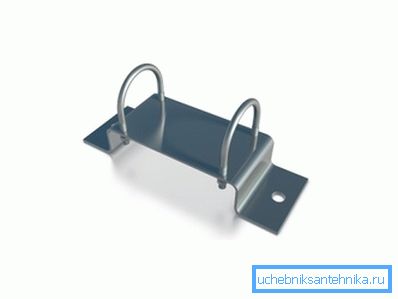
The material for the screed is usually plastic or metal:
- Metal tie - is a split element consisting of the upper and lower parts, which are bolted together. There is also a decorative chrome-plated 25 mm pipe holder, which serves to fix water pipes over the decorative wall covering. Metal clamps are often equipped with rubber gaskets that dampen pipe oscillations during operation, which reduces the level of noise produced by them. Bolts are used to connect the two detachable elements of the clamp. The decorative holder for pipes 20 mm and 25 mm is equipped with a special head that does not violate the attractive appearance of these elements.
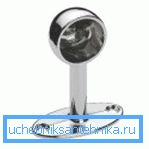
- The plastic tie holder can be either detachable (fixed with latches) or one-piece (U-shaped). In the latter case, the pipe is simply inserted into the fastener until it stops. Such a system allows the manufacture of clamps for parts of complex shape. For example, a holder for an oval tube can be made entirely of plastic.
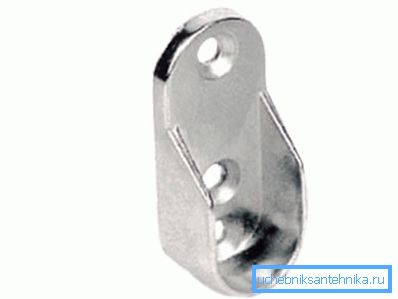
The mounting assembly is located at the bottom of the part.
There are also several varieties:
- T-shaped - fastening is done with a dowel or screw part (screw or anchor);
- L-shaped - the fastener is bent at an angle of 90 degrees.
Kinds of fasteners
There are such types of fasteners:
| Type of fasteners | Description |
| Crimp | With it, you can not only fix the pipe on the wall, but also compress the place of joining, thus providing additional tightness and strength. |
| Guide | It serves to indicate the direction of the pipeline. It does not provide reliable fastening of parts on the surface. |
| Supporting | The main part with which sewer and water pipes are attached. Additionally, they are equipped with rubber gaskets to dampen vibrations and compensate for linear temperature distortion. |
| Safety | It is fixed on difficult sections of pipelines, providing additional rigidity and reliability. |
Regardless of the type of clamp, fasteners are divided into two main types:
- Tough. Crimp or support fasteners are used for it. They are installed on the bell of a sewer pipe, coupling or other shaped part. The main task is to ensure durability and reliability at the junction.
- Floating Here you need to install guides and support types of latches. The diameter of the screed must be larger than the dimensions of the pipeline. In this case, the details of the sewer network can be displaced in the longitudinal direction, thus avoiding temperature distortion of the drainage system.

Tip! In order to avoid deformations, it is also necessary to correctly install the sewage system. In particular, when inserting the smooth end of one pipe into the socket of the other, an appropriate gap of 1 cm should be provided.
Features of mounting pipe supports
Independently installing the sewage system, you should follow certain rules.
Otherwise, accidents are possible, the cost of fixing which far exceeds the cost of fasteners.
- The installation of a domestic sewage disposal system in a heated room should be done using fixed fixings installed at joints and fittings. In this case, you can not be afraid of linear deformations of plastic.
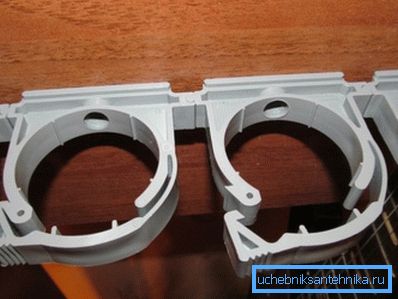
- Floating fixtures that compensate for linear expansion of the pipeline are necessary for fixing the drain pipes used to collect and transport hot effluent (water temperature is above 80 degrees Celsius). In this case, the mobile mounting scheme will protect parts from warping and destruction.
- Before laying pipelines on all surfaces it is recommended to apply a centerline, which will serve as a guideline at the installation stage. This allows you to make sure in advance that the correct slope is observed, to calculate the required length of parts, the number of fittings and fixing clamps. Then the guide elements are attached to the wall, and the support and crimp are mounted together with the pipes.
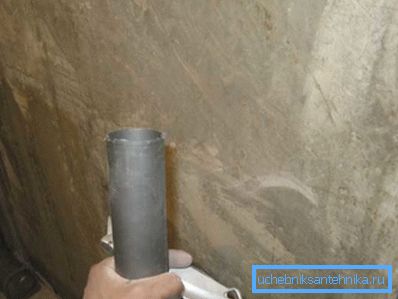
- During installation, the sewage parts are inserted into the fasteners loosely so that they can be moved in the longitudinal direction. The final rigid fixation can be carried out only after the end of the assembly process of the entire system.
- The distance between the individual mounting units is calculated based on the number of shaped parts. If there is a long section of pipe, not equipped with taps, couplings, revisions, and so on, then the step between adjacent fasteners should be no more than 2 meters.
Tip! The most reliable way to fix pipelines is to wall them in a concrete or stone wall. Clamps - only a compromise and cheaper solution.
Conclusion
Careful fixing of parts of the pipeline on the wall guarantees not only reliability, but also the comfort of operating the sewer network. The long non-fixed areas strongly vibrate and make unpleasant sounds.
For more information about the installation of the sewer network can be found in the video in this article.